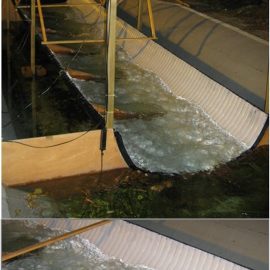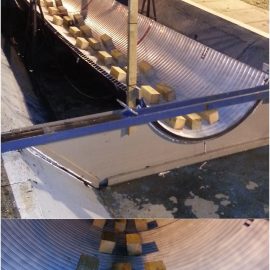Culverts used to convey rivers under roads and embankments are one of the most common small-scale barriers to longitudinal fish movements worldwide. When discharge is high, water velocity in culverts may exceed fish swimming capabilities, and when low, water depth may be insufficient for fish to pass. Such conditions often impede fish movements. Retrofitting culverts with baffles can be a cost effective solution for mitigating habitat fragmentation. Baffles reduce water velocity, increase depth and provide resting areas for fish. Research at ICER has examined the fish passage efficiency and hydraulic conditions created by a number of baffle designs using a 6 m long pipe culvert placed in our large external flume. Corner baffles, debris reducing corner baffles (baffles with an upstream sloping edge) and spoiler baffles have been tested. Passage efficiency tests have been conducted with European eel (Anguilla anguilla) and river lamprey (Lampetra fluviatilis). For eel, baffles improved passage efficiency but the different hydraulic conditions created by alternative baffle designs altered attraction to the culvert barrel. For lamprey, passage remained low once spoiler baffles were installed, suggesting fish either had low motivation to ascend the culvert or were avoiding the physical and/or hydraulic conditions encountered within the culvert. This research was funded by the Environment Agency (England).
Media:
Publications:
Newbold, L.R., Karageorgopoulos, P. & Kemp, P.S. (2014). Corner and sloped culvert baffles improve the upstream passage of adult European eels (Anguilla anguilla). Ecological Engineering 73: 752-759.
Vowles, A.S., Karageorgopoulos, P. & Kemp, P.S. (2019). Upstream movement of river lamprey through a culvert retrofitted with spoiler baffles under experimental conditions. Journal of Ecohydraulics, doi:10.1080/24705357.2018.1555777.
People:
Dr Lynda Newbold
Dr Andrew Vowles
Prof Paul Kemp


